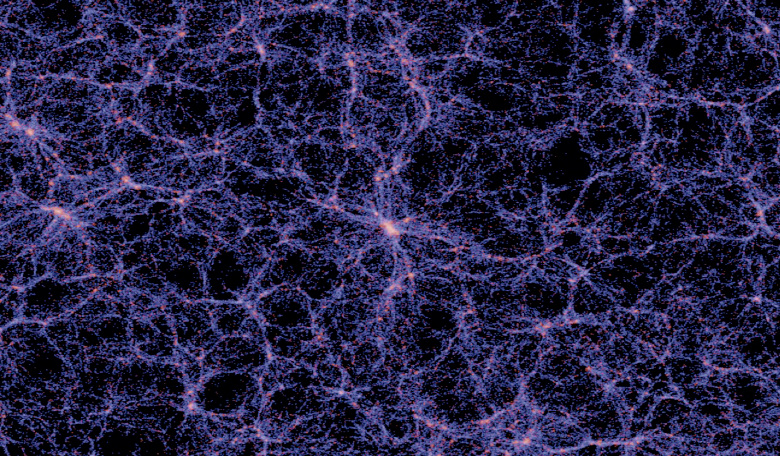Astronomers using the Giant Metrewave Radio Telescope (GMRT) in India have observed a linearly aligned triplet of gas rich dwarf galaxies – this highly unusual system in an extremely low density environment is suggested to show the slow formation of galaxy mergers along filamentary pathways in the voids of the cosmic web.
The cosmic web can be thought of as just that – a vast web-like structure formed by all of the galaxies in the Universe, linked by long tenuous threads of gas that are thought to permeate the Universe. It is thought that matter ‘flows’ along these threads and at the intersections of these filaments galaxies merge to become clusters, and then super clusters through the influence of gravity. The seeds for this web can be seen in the tiny fluctuations within the CMB and indeed, in regions of the sky containing two galaxy clusters, smaller groups of galaxies can be seen tracing out a line between the clusters.
The space in between that makes up the holes of the web are known as ‘voids,’ however these voids are not exactly voids in the strictest sense of the word. These regions are low density regions and are produced by the streaming of matter out towards the higher density walls and filaments. They are also considered smaller versions of the bigger cosmic web in that have their own filamentary structures and high density regions at the intersection of the filaments.
The study of voids has thus become a growing interest and recent surveys such as the Void Galaxy Survey (VGS) have found that there is more to these apparently empty spaces than meets the eye. Now a team of astronomers whose lead author in a recent paper is J N Chengalur from the National Centre for Radio Astrophysics, Pune, India, have found evidence that a trio of unusual dwarf galaxies could represent the flow of material along a filament inside a void.
The system in question is UGC 3672, and it is found in the relatively near-by Lynx-Cancer void – a well studied void located at the edge of the Local Volume, and a void that contains some of the most metal-poor and gas-rich galaxies known.
UGC 3672 consists of three dwarf galaxies, the faintest of which is extremely gas-rich and also extremely metal deficient but is also thought to be the site of recent star formation. UGC 3672 is described by Chengalur and colleagues as a scaled down version of a nearby interacting group of galaxies known as M81. Despite being roughly five times larger than UGC 3672, M81 has been observed to contain tidal streamers and bridges connecting the galaxies – features that are also seen in UGC 3672.
These features, coupled with the linear alignment of the galaxies has prompted the team to suggest that UGC 3672 is consistent with the system lying along a filament. Not only that but “ the location of this highly unusual system in an extremely low density environment is not a coincidence, but is a consequence of structure formation proceeding more slowly.” In other words UGC 3672 could represent an early example of [galactic] structure formation, similar to ones seen in a low density Universe.
For more information on this research, see; https://arxiv.org/pdf/1611.01271.pdf











